
The Solar-Terrestrial Centre of Excellence (STCE) is a collaborative network of the Belgian Institute for Space Aeronomy, the Royal Observatory of Belgium and the Royal Meteorological Institute of Belgium.
 |
Published by the STCE - this issue : 26 Sep 2013. The Solar-Terrestrial Centre of Excellence (STCE) is a collaborative network of the Belgian Institute for Space Aeronomy, the Royal Observatory of Belgium and the Royal Meteorological Institute of Belgium. |
| Archive of the newsletters | Subscribe to this newsletter by mail |
All solar observers and space weather monitors have noticed it: Over the last few weeks, solar activity has dropped again to very low levels.
Indeed, as can be seen in the first part of this movie (SDO; http://youtu.be/ZOQIkLdgZSA), sunspots have been really scarce for about 2 weeks starting 5 September. Between 8 and 12 September, a few tiny sunspot groups performed a perfect relay to avoid an otherwise spotless solar disk. It would have been the first spotless day since 14 August 2011! Images from 10 and 16 September underneath were made using the white light telescope of the Uccle Solar Equatorial Table (USET). In both cases, they show only one tiny sunspot group on the solar surface.
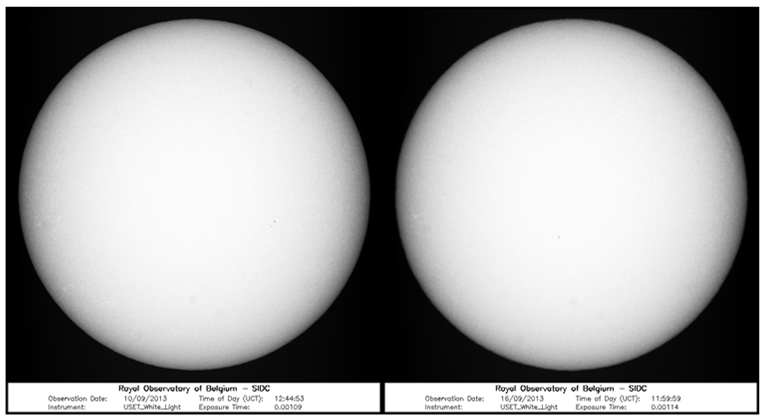
The graph below shows the evolution of the smoothed monthly sunspot number (blue) since 1976, and the lowest daily sunspot number recorded for these months (red; unsmoothed). Low daily sunspot numbers, similar to the ones recorded over the last few weeks, are very uncommon during the maximum years of solar cycles (SC) with a moderate to high amplitude such as SC21 to 23. In this respect, SC24 looks very similar to other low activity solar cycles that occurred e.g. around the 1900's.
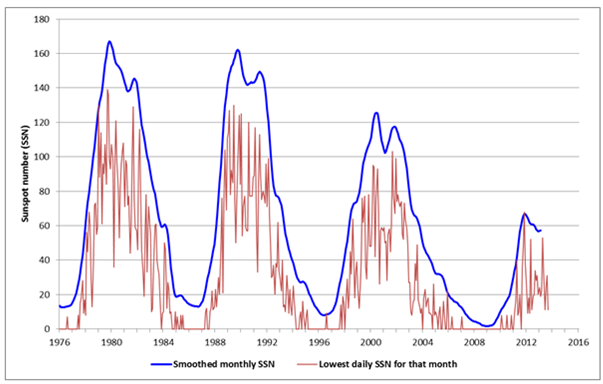
The low solar activity was also noticeable in other solar indices, such as the x-ray flux measured by the GOES satellite which displayed a pronounced low between 7 and 17 September (see part 2 of the movie at http://youtu.be/ZOQIkLdgZSA with images from GOES' Solar X-ray Imager). In fact, for this period of 11 consecutive days, not a single solar flare was recorded, not even in the low C-class! Since measurements began in the mid-1970's, there have been no such long periods without C-flares during the maximum years of the solar cycles. A similar story can be told for the medium flares ("M-class"), with the most recent M-flare dating back already from 17 August.
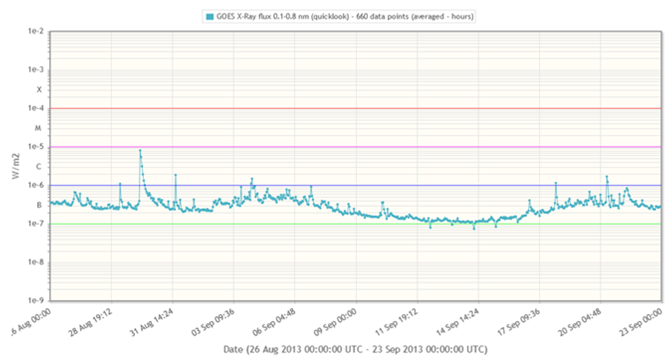
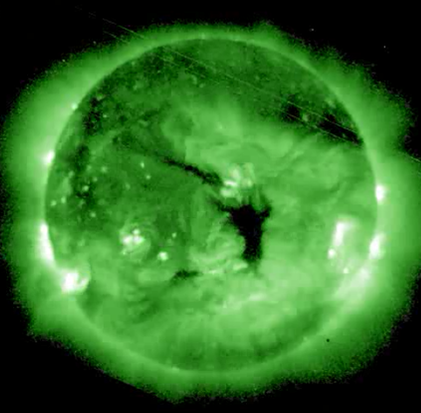
Hence, it will come as no surprise that also geomagnetically, we have experienced some very quiet weeks. Indeed, the last (minor) geomagnetic storm dates back from 27 August. However, the current stormless period of about a month is not so extraordinary compared to the previous three solar cycles. These cycles all had 2 or 3 periods with up to 6 weeks of geomagnetic calm during their years of maximum solar activity. SC24 does distinguish itself from the three others by having several 2-month periods with no geomagnetic storming. The longest stretch occurred from 25 November 2012 till 28 February 2013, or 96 days without strong geomagnetic disturbances.
It will be interesting to see if and when the Sun is going to wake up from this prolonged nap!
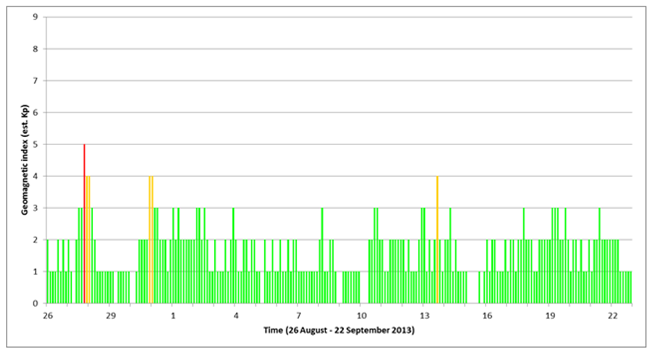
Credits - Data and imagery were taken from SDO/HMI (http://sdo.gsfc.nasa.gov/), GOES/SXI (http://www.swpc.noaa.gov/sxi/index.html), NOAA/SWPC (http://www.swpc.noaa.gov/Data/index.html), WDC for Geomagnetism/Kyoto (http://wdc.kugi.kyoto-u.ac.jp/wdc/Sec1.html), SIDC (http://www.sidc.oma.be/index.php), USET (http://www.sidc.oma.be/uset/index.php).
The morning of September 1, 1859, the English astronomer Richard Carrington studies as usual the Sun in his private observatory. While making drawings of sunspots, he notes 2 white light flashes of which the range and intensity suddenly grows and disappears after a few moments. The next day, compasses were not able to point north, the telegraph bursted with anger. The early seeds of something like Space Weather were planted, although it was not yet called like that at those times.
Now, more then 150 years later, Space Weather is an emerging field that impacts a broad spectrum of groups and human activities. There is no international consensus on a definition of Space Weather, but we can state that Space Weather describes the conditions in space that affect Earth and its technological systems.
Since a few decades, space Weather scientists have done a lot of research and want to share their knowledge and understanding. As such, we organize Space Weather for Engineers. This course aimes to make people, and engineers in particular, aware of the solar or spatial origin of the disturbances and disruptions that are witnessed in many ground based and spatial technological systems, and to explain the physical mechanisms behind them, to indicate where to find the relevant predictive data and to train how to interpret them in order to lower the risk of damage to technical equipment and economic losses. As a matter of fact, Space Weather predictions are readily available nowadays and the Space Weather community has been working hard to make them widely accessible.
Space Weather for Engineers is only 1 click away: http://www.stce.be/sw4e/
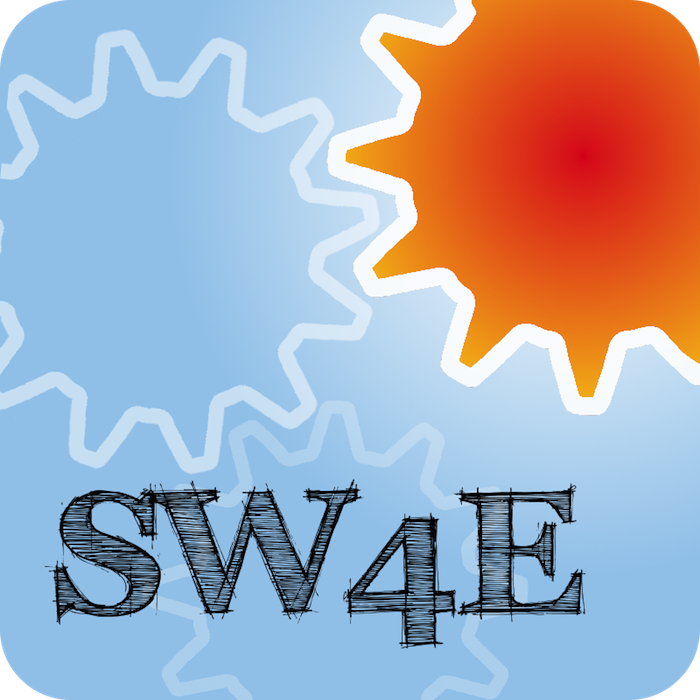
Solar (flaring) activity evolved from very low to low until Saturday, and back to very low on Sunday.
In order to view the activity of this week in more detail, we suggest going to the following website from which all the daily (normal and difference) movies can be accessed: http://proba2.oma.be/ssa.
This page also lists the recorded flaring events.
Details about some of this week's events, can be found further below.
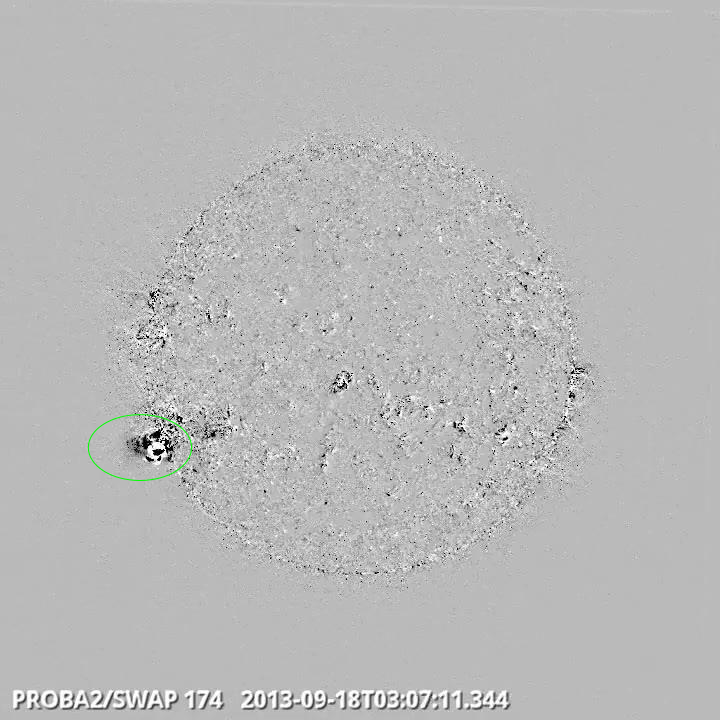

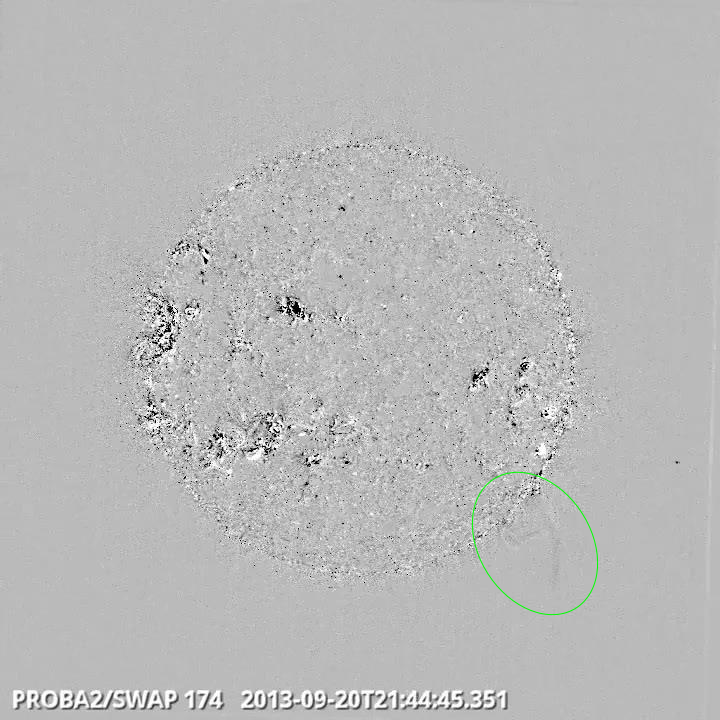
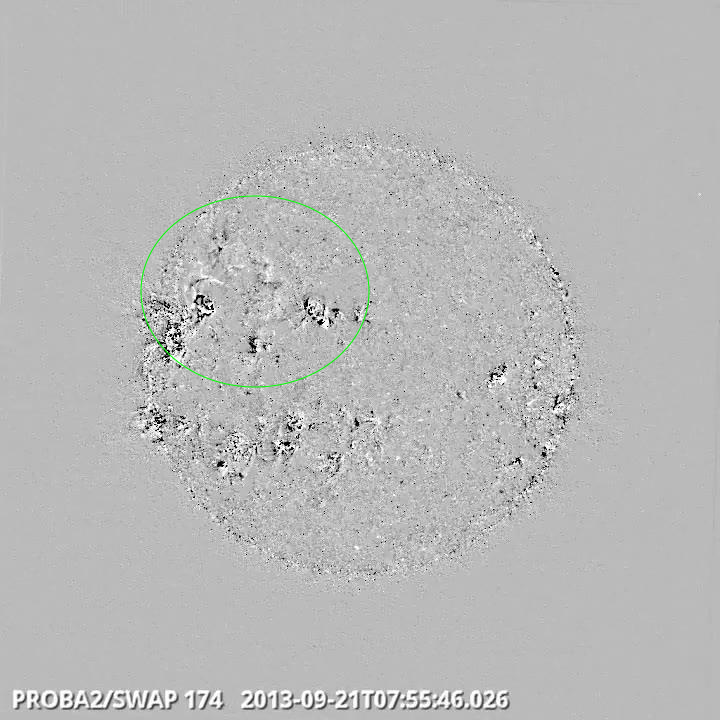
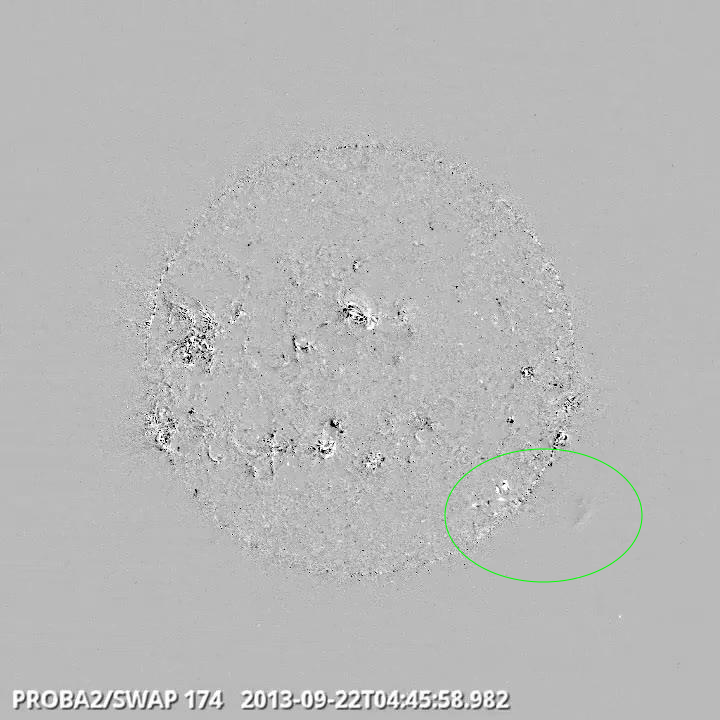
During this week the flaring activity was very low, with only nine low C-class flares reported by GOES. The strongest flare of the week was the C3.9 flare on September 18, peaking at 03:15 UT. The flare originated from the NOAA AR 1846 which was at that moment situated at the east solar limb.
A prominence erupted near the Catania sunspot group 76 (NOAA AR 1845) on September 19 around 3UT. The eruption was associated with a coronal dimming, an EIT wave (see the section 'proba2' of this STCE newsletter) and a partial halo CME. The CME was first observed in the SOHO/LASCO C2 field of view at 03:48 UT, had an angular width of about 180 degrees and a speed around 300 km/s. Note that the measured speed is always a projected speed. This means that the plasma travelling through the 3 dimensional space is projected in the 2 dimensional plane of view of the coronograph. The bulk of the CME mass was directed southward of the ecliptic plane. The first picture is a series of SDO/304 images in which the plasma of the prominence rises and is finally ejected. The second picture is a view of the coronal mass ejection in the coronograph LASCO/C2.
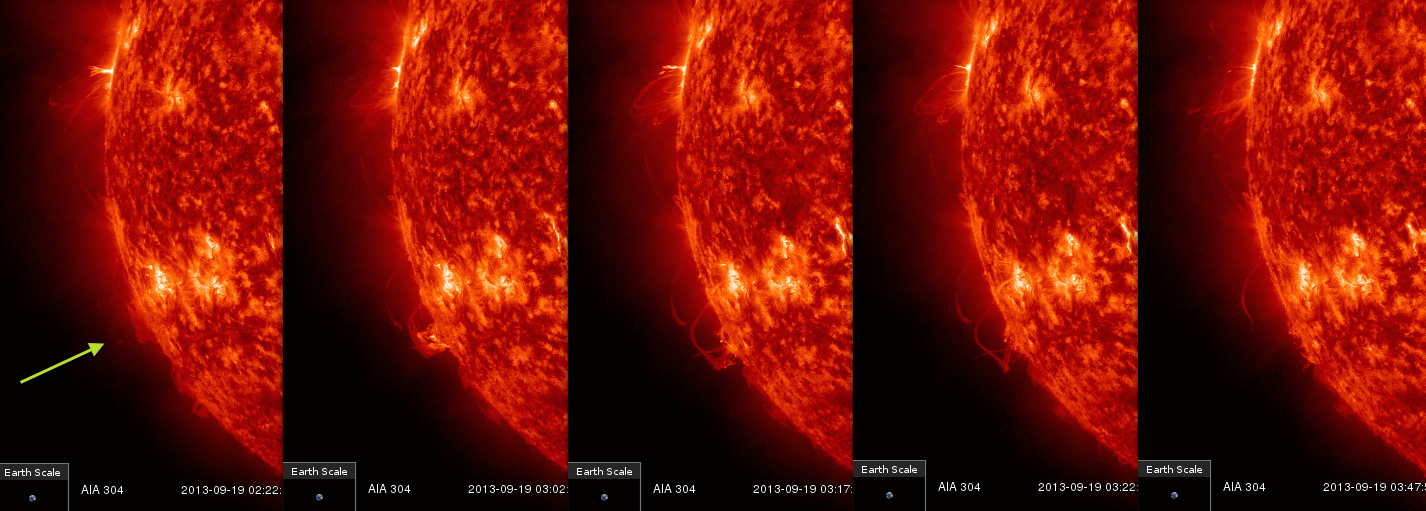
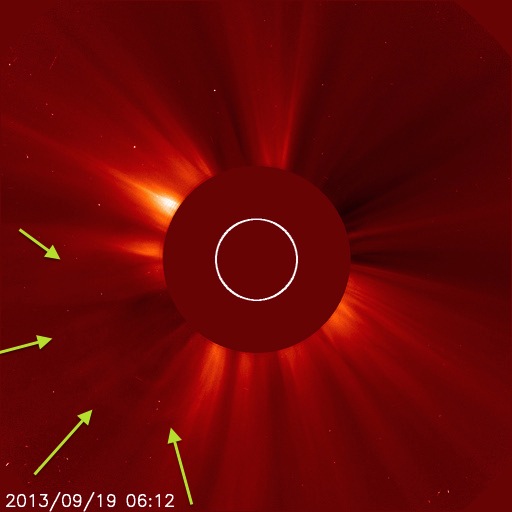
A northern coronal hole (CH) situated between 20° and 55° latitude, with a width of 10°, was observed this week. The CH reached the central meridian on September 19.
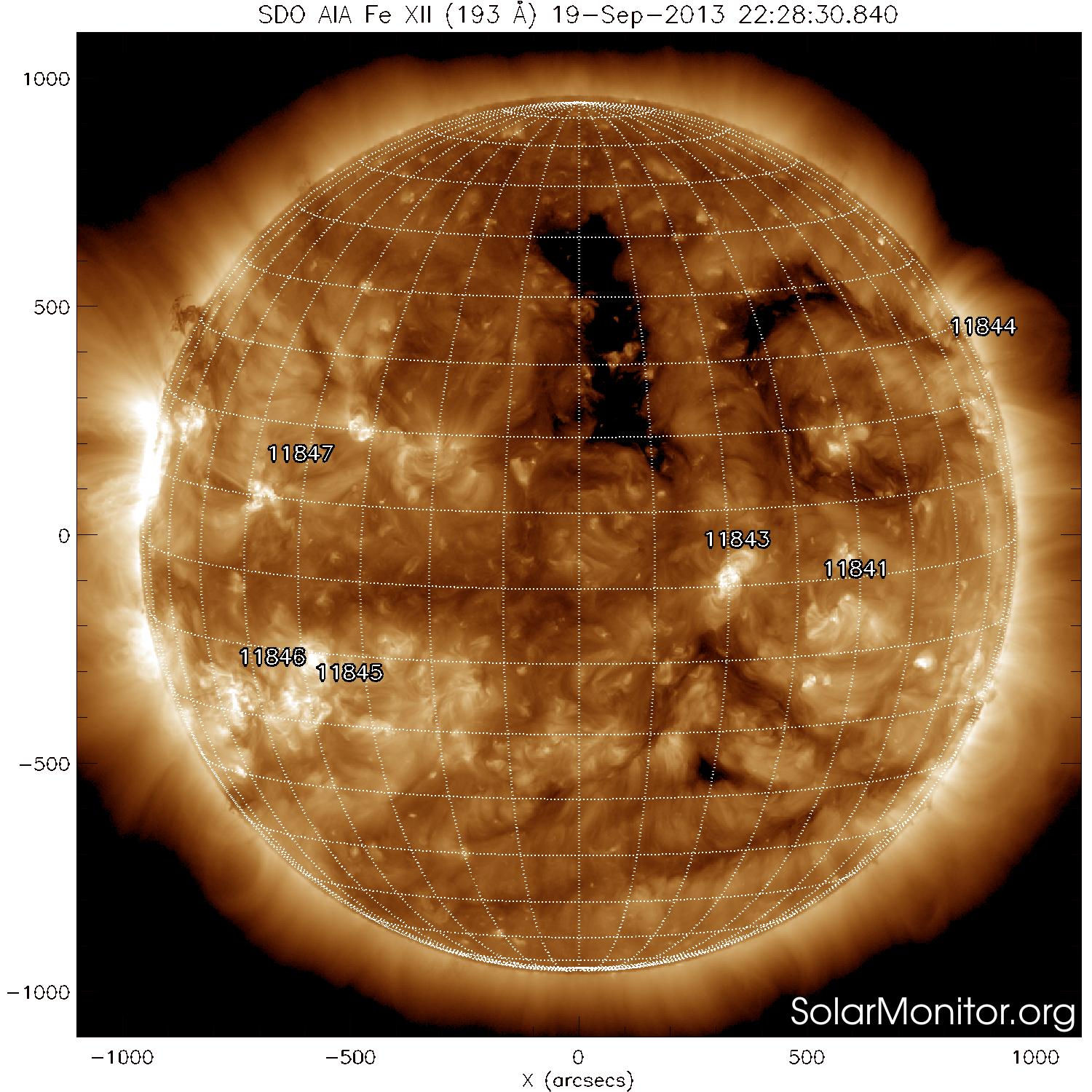
A co-rotating interaction region (CIR) characterised by a stronger magnetic field and denser solar wind plasma arrived at the Earth in the afternoon of September 18. In this region, a slow and fast wind interact. The interplanetary magnetic field (IMF) magnitude had the maximum value of about 10 nT on September 18. The solar wind curve increased rather smoothly in the course of the day to a value around 600 km/s on September 19. This fast wind is associated with the CH that reached the central meridian on September 13. The graph below shows the solar wind ACE data from September 19 up to September 21 with the speed in the top panel, density in the second panel, the total IMF in the third panel and the z-component of the IMF in the bottom panel.
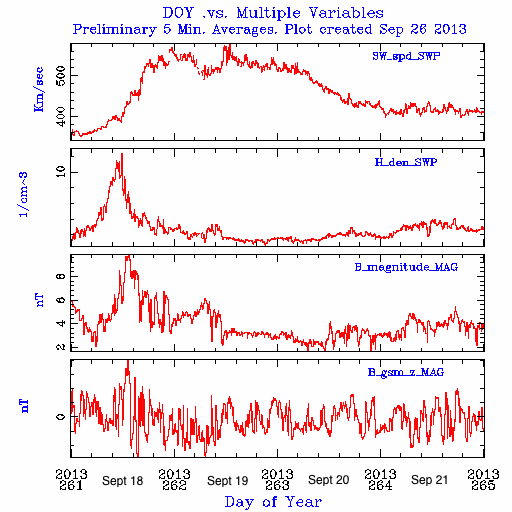
During the rest of the week, the IMF magnitude was stable around 5 nT.
We can already give a glimpse on the bulletin of next week. The fast stream linked with the CH mentioned in the section 'Solar Activity' and which was at the central meridian on September 19, did arrive. More next week.
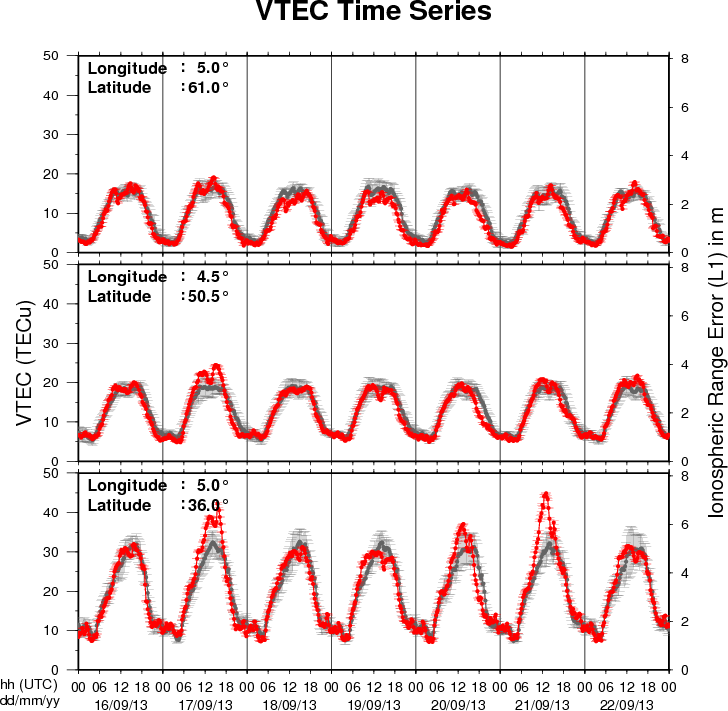
The figure shows the time evolution of the Vertical Total Electron Content (VTEC) (in red) during the last week at three locations:
a) in the northern part of Europe(N61°, 5°E)
b) above Brussels(N50.5°, 4.5°E)
c) in the southern part of Europe(N36°, 5°E)
This figure also shows (in grey) the normal ionospheric behaviour expected based on the median VTEC from the 15 previous days.
The VTEC is expressed in TECu (with TECu=10^16 electrons per square meter) and is directly related to the signal propagation delay due to the ionosphere (in figure: delay on GPS L1 frequency).
The Sun's radiation ionizes the Earth's upper atmosphere, the ionosphere, located from about 60km to 1000km above the Earth's surface.The ionization process in the ionosphere produces ions and free electrons. These electrons perturb the propagation of the GNSS (Global Navigation Satellite System) signals by inducing a so-called ionospheric delay.
See http://stce.be/newsletter/GNSS_final.pdf for some more explanations ; for detailed information, see http://gnss.be/ionosphere_tutorial.php
Start : 2013-10-07 - End : 2013-10-11
The aim of the workshop is to review the "state of the art"
theories about generation and propagation of Solar radio burst and
discuss the observational constrains and results that have been
provided in this area by the WIND & STEREO missions during the
last 20 years. Furthermore the STEREO & WIND observations will
be put in the context of other missions such as RHESSI and ground
based observatories. Finally, the preparation for the future
explorations foreseen with Solar Orbiter and Solar Probe Plus will
be discussed.
Website:
http://type3stereo.sciencesconf.org/
Start : 2013-10-24 - End : 2013-10-26
Initiated by Profs. Fang and Choudhury, the first Asian-Pacific
Solar Physics Meeting (APSPM) was held in Bangalore two years ago.
During the meeting, a consensus was achieved that it might be a
good idea to have the APSPM every three years. Somehow the second
APSPM was proposed to be held by mainland China in 2013. APSPM is
aimed to exchange the recent research results in solar physics in
the emerging asian-pacific region.
Asian-pacific regions are getting more and more active in solar
physics, as signified by the construction of big facilities,
including the Hinode satellite (Japan), SOXS (India), Chinese Solar
Radio Heliogragh, and Optical & Near-Infrared Solar Eruption
Tracer (ONSET). Therefore, colleagues have agreed to hold regional
solar physics meetings regularly. The first Asian-Pacific Solar
Physics Meeting (APSPM) was held in Bangalore during March 22-24
2011. During the meeting, a consensus was achieved that it might be
a good idea to have the APSPM every three years. Somehow the second
APSPM was proposed to be held by mainland China in 2013. APSPM is
aimed to exchange the recent research results in solar physics in
the emerging asian-pacific region.
Website:
http://sdac.nju.edu.cn/~solar/
Start : 2013-10-27 - End : 2013-10-31
Magnetic helicity has been intensively studied from
observational, theoretical, and many other aspects of solar
physics. For this meeting we would like to invite solar physicists
who are interested in the observational and theoretical studies of
the helicity, to encourage thorough discussions on the relevant hot
issues. The 1st Helicity Thinkshop was held successfully in 2009,
and now the 2nd one will be held on October 27-31, 2013 in Beijing,
China.
Website:
http://sun.bao.ac.cn/meetings/HT2013/
Start : 2013-10-28 - End : 2013-11-02
The Worshop and School on Radio Sun in Beijing and Inner
Mongolia during Oct.28 - Nov. 2, 2013 is the first international
academic seminar supported by the International Research Staff
Exchange Scheme of the Seventh Fromework Programme of the European
Union (FP7-IRSES-295272-RADIOSUN).
The primary aim of this programme is to establish close research
interaction and collaboration between the key research groups
involved in CSRH, SSRT, and ALMA projects and in development of
relevant theory and data analysis tools, through the systematic
research staff and knowledge exchange, joint research efforts
exploiting existing data and facilities, and preparing the future
world-class partnership in exploitation of the upcoming
facilities.
The Workshop and School welcome all solar physicsts and students
who are interested in solar radio astronomy to participate. We will
discuss and exchange the scientific frontier problems, including
the new-generation radio instruments (CSRH, Siberian
multi-frequency radioheliograph, LOFAR, ALMA, and other new
instruments), recent achievements and their scientific goals;
methods and techniques of data processing (for example, software,
radio image reconstructions, and method for studying various types
of solar radio fine structures); and the objectives of new
observational data and new mathematical methods.
Website:
http://beijingradiosun.csp.escience.cn/
Start : 2013-11-11 - End : 2013-11-22
Magnetic fields play an important role in many astrophysical
processes. But magnetic are difficult to detect and to model or
understand, since the fundamental equations describing the behavior
of magnetized plasmas are highly non-linear. Hence, magnetic fields
are often an inconvenient subject which is overlooked or simply
neglected. Such difficulty burdens the research on magnetic fields,
which has evolved to become a very technical subject, with many
small disconnected communities studying specific aspects and
details.
The school tries to amend the situation by providing a unifying
view of the subject. The students would have a chance to understand
the behavior of magnetic fields in all astrophysical contexts, from
cosmology to the Sun. From star-bursting regions to AGNs in
galaxies. The school will present a balanced yet complete review of
our knowledge. Extensions into the unknown are also important to
indicate present and future lines of research.
The Winter School will bring together in a relaxed working
atmosphere a number of the leading scientists in this field, PhD
students and recent postdocs. The conditions for a successful
interaction will be granted, including two special sessions for
those students that want to present their own work.
Website:
http://www.iac.es/winterschool/2013/
Start : 2013-11-12 - End : 2013-11-15
Since its launch in Sep-2006, more than 600 refereed papers have
been published based on Hinode observations, presenting many new
and important findings to the scientific community. However, due to
the unexpectedly low levels of solar activity, until now the focus
has mainly been on the more quiescent aspects of the solar cycle.
With the solar maximum expected this year, through cooperative
observations with SDO, IRIS, and ground based observatories, Hinode
observations should lead to our understanding of active Sun
phenomena, such as solar flares and CMEs, to be greatly improved.
Making Hinode-7 an excellent opportunity to discuss solar activity
in the current solar cycle and the related science through the use
Hinode data, as well as other solar/space weather data. It will
also be interesting to use this meeting to broaden our focus to
include the solar-stellar connection as a means to deepen our
understanding of solar activity.
Momentum is also gaining for Solar-C, which is being developed
as an international collaboration between Japan, US and Europe. To
further discuss this mission, the Solar-C science meeting will be
held on 11-Nov.
Website:
http://www.kwasan.kyoto-u.ac.jp/hinode-7/
Start : 2013-11-13 - End : 2013-11-13
Most space weather occurs due to the Sun's emissions which
can affect the Earth's space environment. Modern society is
ever more dependent upon ground-based & spaceborne technology
which can be vulnerable to space weather. Satellites, GPS, aviation
& the electric power industry are all at risk from this &
hence space weather is now included on the UK's National Risk
Register. It is important to have long-running, continuous
observations for forecasting, nowcasting & for research in
space weather. This public meeting, held during the peak of the 11
year solar cycle, addresses the deficiency in continuous, long-term
observations & how this might be overcome.
Website:
http://www.rmets.org/events/space-weather-importance-observations
Start : 2013-11-18 - End : 2013-11-22
This International CAWSES-II Symposium hosted by SCOSTEP
(Scientific Committee on Solar-Terrestrial Physics) will provide an
excellent opportunity to discuss the scientific accomplishments of
CAWSES-II and look forward to SCOSTEP's future programs at a moment
toward the end of its five-year period. The symposium will cover
the six major themes of CAWSES-II tasks: 1) What are the solar
influences on the Earth's climate?, 2) How will geospace respond to
an altered climate?, 3) How does short-term solar variability
affect the geospace environment?, 4) What is the geospace response
to variable inputs from the lower atmosphere?, 5) Capacity
Building, 6) Informatics and eScience. The main functions of
CAWSES-II are to help coordinate international activities in
observations, modeling, and applications crucial to achieving this
understanding, to involve scientists in both developed and
developing countries, and to provide educational opportunities for
students of all levels. The symposium offers keynotes/lectures that
will be interesting for all participants every morning and more
specific sessions of presentations in the afternoon. We welcome all
those who are involved and/or interested in CAWSES-II to Nagoya in
the autumn when we will have the pleasure of being surrounded by
beautiful colorful leaves of this season.
Website:
http://www.cawses.org/CAWSES/leaflet_CAWSES-II_120229.pdf
Start : 2013-11-18 - End : 2013-11-22
The 10th Edition of the European Space Weather
Week will take place on 18-22nd
November 2013 in Belgium. The venue will be confirmed early next
year, but mark your calendars now for the 10th Anniversary of this
growing European event.
The ESWW will again adopt the central aim of bringing together
the diverse groups in Europe working on different aspects of Space
Weather
. This includes but isn't
limited to the scientific community, the engineering community,
applications developers, service providers and service end users.
The meeting organisation will again be coordinated by the Belgian
Solar-Terrestrial Centre of Excellence (STCE), ESA
and the Space Weather
Working Team. The local
organisation will be done by the STCE.
Website:
http://www.stce.be/esww10/
Start : 2013-11-26 - End : 2013-11-28
The 1st SPRING (Solar Physics Research Integrated Network Group)
workshop is being held from November 26 - 28, 2013 at the scenic
Brugger's Hotel Park by Titisee hosted by the Kiepenheuer-Institut
für Sonnenphysik in Freiburg, Germany.
The purpose of the workshop is to work on the scientific
requirements for a new ground-based network of telescopes for
full-disk synoptic observations of the Sun.
The desire for such a new network is motivated by new scientific
research directions in solar physics, the requirement of real-time
context data for high-resolution solar telescopes, and the need of
continuous, long-term, consistent, and reliable solar data as
foundation for space weather prediction.
Website:
http://www3.kis.uni-freiburg.de/~mroth/spring.html
Start : 2013-12-13 - End : 2013-12-13
The inclusion of space weather in the National Risk Assessment
in 2012 means that there is now an urgent need for dialogue between
those doing the science of space weather and those using the data
to forecast, understand and mitigate the risks.
Since the Sun is currently at the peak of its cycle - a time
when space weather events become more frequent - we have a timely
opportunity to study how a range of solar activity ultimately lead
to magnetospheric, ionospheric and ground level disturbances.
The goal of this meeting is to bring together those working
across the broad range of space weather activities in the UK to
discuss the current status of observations and recent new advances
in the theories and models of the phenomena of space weather.
Website:
http://www.mssl.ucl.ac.uk/~lmg/spaceweather/Overview.html
Start : 2014-06-23 - End : 2014-06-27
The meeting in honour of Prof. Zdenek Svestka will cover issues
of the physics of solar and stellar flares.
Website:
http://solarflares2014.cz/
Start : 2014-08-02 - End : 2014-08-10
The 40th COSPAR Scientific Assembly will be held in Moscow,
Russia from 2 - 10 August 2014. This Assembly is open to all bona
fide scientists.
Website:
http://www.cospar-assembly.org/
Start : 2014-08-31 - End : 2014-09-05
Low-frequency waves (ULF, ELF and VLF) in space plasmas have
been studied for many decades. In our solar system, such waves
occur in the magnetospheres of planets and in the solar wind; more
recently they have also been confirmed on the Sun. In spite of the
great differences in the plasma properties of these regions, the
overarching schemes are wave generation, wave propagation, and wave
dissipation, which are three fundamental aspects of any kind of
waves. A fourth aspect of these waves is their application, either
with direct benefit to humans or for scientific pursuit. Therefore,
this Chapman conference will provide a forum in which various wave
communities can come together and discuss recent achievements of
observational, theoretical, and modeling studies.
Website:
http://chapman.agu.org/spaceplasmas/
Start : 2014-09-08 - End : 2014-09-12
The European Solar Physics Meetings aim to highlight all aspects
of modern solar physics, including observation and theory that span
from the interior of the Sun out into the wider heliosphere. These
meetings provide a broad, yet stimulating, environment for European
and international scientists to share their research in solar
physics.
The meeting will mostly comprise of contributed talks and poster
presentations, with several invited review talks (typically one per
session). Posters will be on display for the whole meeting in close
proximity to the lecture theatre. Refreshments will be served in
the poster viewing area during two dedicated coffee/poster breaks
on each full day.
Website: http://www.espm14.ie/
Start : 2015-06-22 - End : 2015-06-26
The Fourteenth International Solar Wind Conference will be held
for the first time ever in China, from 22 to 26 June 2015, at
Weihai in the Shandong province. It will be jointly organized by
the School of Earth and Space Sciences of Peking University and the
newly-established Institute of Space Sciences of Shandong
University. The meeting will take place in the Space Science
Building of Shandong University, a venue located within walking
distance to the beautiful Weihai International Bathing Beach, one
of the most popular scenic areas of northern China.
The conference will cover all aspects of solar wind physics,
with invited reviews and contributed papers that examine the
current research and outline the future research in all the
relevant solar wind fields.
Website: not available yet